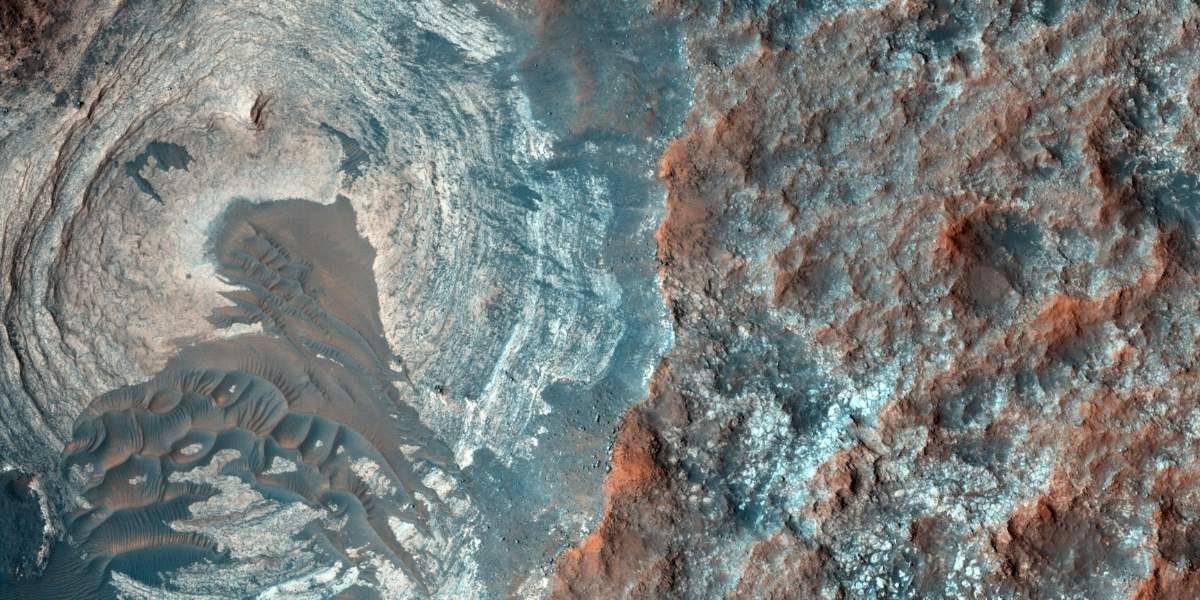The Formation and Geology of Olympus Mons
Olympus Mons, towering over the Martian surface, is the largest volcano and tallest planetary mountain in our solar system. This colossal shield volcano rises about 22 kilometers (13.6 miles) above Mars’ mean surface level, nearly three times the height of Mount Everest on Earth. Formed by successive lava flows over millions of years, its gently sloping flanks stretch approximately 600 kilometers (373 miles) in diameter, covering an area roughly the size of the state of Arizona.
The volcano’s formation is attributed to Mars’ unique tectonic and volcanic conditions. Unlike Earth, Mars lacks plate tectonics, allowing lava to accumulate in one location for extended periods, creating enormous shield volcanoes. Olympus Mons’ composition primarily consists of basaltic lava, which flows easily and spreads widely, contributing to the volcano’s vast size and gentle slopes.
Its geological features include a caldera complex at the summit, numerous lava channels, and steep cliffs along its edges called scarps. Studying Olympus Mons offers vital insights into Martian volcanic activity and planetary geological processes.
Read Also: The Stellar Journey: From Nebula to Remnant of the Sun
How Olympus Mons Reveals Mars’ Volcanic Activity
Olympus Mons is a testament to the intense volcanic activity that shaped early Mars. The volcano’s layers indicate multiple eruptive phases, showcasing long-lasting and episodic lava flows. Radiometric dating of Martian surface materials suggests volcanic activity persisted over several hundred million years.
The volcano’s massive size and structure imply a stable magma source beneath the Martian crust. This sustained magmatic activity contrasts with Earth’s more transient volcanic centers affected by moving tectonic plates.
Moreover, the low gravity and thin atmosphere of Mars influence lava behavior, allowing it to travel further and create the extensive shield volcano form. Olympus Mons thus encapsulates Mars’ volcanic history, aiding our understanding of how the planet’s interior evolved.
What Does Olympus Mons Tell Us About Planetary Evolution?
Olympus Mons provides clues about Mars’ thermal and geological evolution. The volcano’s existence indicates that Mars once possessed significant internal heat to fuel prolonged volcanism. This heat likely contributed to shaping the planet’s crust and surface features.
As volcanic activity declined, the cooling of Mars’ interior led to the planet’s current geologically inactive state. Understanding the timeline and scale of Olympus Mons’ eruptions helps scientists reconstruct Mars’ thermal history and infer its potential for past habitability.
Additionally, the study of Olympus Mons aids comparative planetology, highlighting differences between Earth’s active tectonics and Mars’ stagnant lid regime. These insights inform models of planetary formation, volcanic processes, and planetary atmospheres.
How Have Space Missions Enhanced Our Knowledge of Olympus Mons?
Space missions have revolutionized our understanding of Olympus Mons. Orbiters like NASA’s Mars Reconnaissance Orbiter (MRO) and ESA’s Mars Express have provided high-resolution imagery and topographic data, revealing intricate details of the volcano’s structure and composition.
Instruments such as spectrometers have identified mineral compositions, helping decipher volcanic rock types and alteration processes. Radar mapping uncovered subsurface features, like lava tubes and layered deposits.
Future missions, including proposed landers or rovers, aim to sample Olympus Mons’ surface directly, providing ground truth for orbital observations. These missions enhance our ability to understand Mars’ geological past and its potential to support life.
What Challenges Does Olympus Mons Present for Exploration?
Despite its scientific value, Olympus Mons poses significant challenges for exploration. Its immense size and steep scarps make landing and traversing the terrain difficult. The low atmospheric pressure on Mars complicates entry, descent, and landing operations, especially on elevated surfaces like Olympus Mons’ summit.
Moreover, extreme temperature variations and dust storms present operational hazards. Communication delays and limited solar power availability add complexity to sustained missions.
Designing robotic or human exploration systems capable of safely studying Olympus Mons requires innovative engineering and planning. Overcoming these challenges is crucial for unlocking the volcano’s secrets.
Read Also: Comparing Earth to Other Rocky Planets in Our Solar System
Why Is Olympus Mons Central to Understanding Mars and Beyond?
Olympus Mons is not only a geological marvel but also a key to unlocking Mars’ past and future. Studying this megastructure enhances our comprehension of volcanic processes under different planetary conditions and broadens our understanding of planetary evolution.
Insights from Olympus Mons inform theories about Mars’ potential habitability, resource availability, and environmental changes over time. This knowledge supports planning for future exploration and potential colonization.
Olympus Mons serves as a natural laboratory for comparative planetology, helping scientists understand volcanic and tectonic diversity across the solar system. Its grandeur inspires continued curiosity and scientific discovery.






